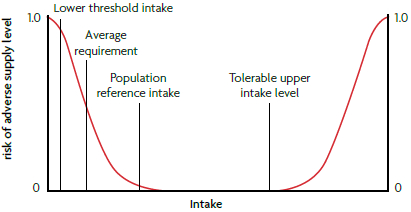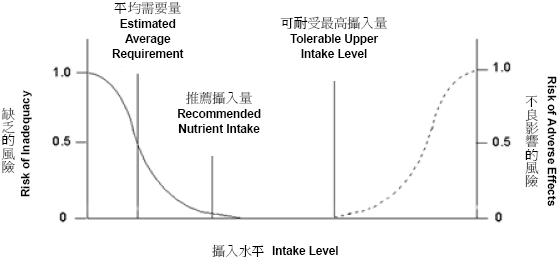Getting the measure of diet jargon. They are used widely in.
 What Are Dietary Reference Values Drvs Eufic
What Are Dietary Reference Values Drvs Eufic
Der kan vre mere end n definition af RNI.

Reference nutrient intakes definition. Lower Reference Nutrient Intakes LRNI. Reference intakes for energy total fat saturates sugars and salt. The RNI is the amount of a nutrient that is enough to ensure that the needs of nearly all the group 975 are being met.
They are used by nutrition and health professionals in dietary assessment and diet planning at population and individual level. LRNI lower reference nutrient intake. For some nutrients a safe intake is given and for carbohydrate and fat individual minimum maximum and population averages are specified 10.
The RDA is a target or recommended intake. Reference Nutrient Intakes RNI used for protein vitamins and minerals are an estimate of the amount that should meet the needs of most of the group to which they apply. The percentage RI for certain nutrients may also be repeated on the front of the pack.
De er listet til venstre nedenfor. The nutrient intakes of free-living groups Beaton 1994. Estimated Average Requirements EAR used in particular for energy.
Lower reference nutrient intake LRNI. Recommended Dietary Allowance RDA. Looking at the amount of each nutrient in 100g or a portion of a food can give you an idea of how much it contributes to your daily intakes.
These values indicate the amount. Medicine and health Clinical Medicine. They include both recommended intakes and ULs as reference values see Box 1.
Reference nutrient intake in A Dictionary of Dentistry. This information is sometimes also written on the label as a percentage of the reference intake or RI. Andre betydninger af RNI Ud over Referenceindtag af nringsstoffer har RNI andre betydninger.
These values which vary by age and sex include. This DRI system is used in both the United States and Canada. The lower reference nutrient intake LRNI the estimated average require - ment EAR and the reference nutrient intake RNI.
02042020 Dietary Reference Intakes DRIs are a set of reference values used to plan and assess nutrient intakes of healthy people. Information on the RI and the contribution a nutrient makes towards a RI expressed as a percentage can usually be found on the back or side of packaging. The RDA for each nutrient is set at a value that should be ade-quate for 97 to 98 percent of all individuals in a life stage group given a specified definition of adequacy.
Nutrient intake that is less than the RDA. Therefore the DV tends to be higher than the RDI. Average daily level of intake sufficient to meet the nutrient requirements of nearly all 97-98 healthy people.
Three values for most nutrients. Included within this definition are three types of estimates. 20012021 In short the Recommended Daily Intake RDI tries to define how much of a nutrient each person should have based on their age and gender.
Reference Nutrient Intakes RNIs Estimated Average Requirements EARs and Lower Reference Nutrient Intakes LRNIs. The RNI gives for each vitamin and mineral the recommended amount for different ages from babies to adults. Reference Nutrient Intake RNI refers to the recommended amount of vitamins and minerals required by the different ages from babies to adults and where suitable the different amounts required by pregnant or nursing mothers and other special cases.
Dietary Reference Values DRVs is an umbrella term for the complete set of nutrient reference values which include the Population Reference Intakes PRIs the Average Requirements ARs Adequate Intakes AIs and Reference Intake RIs ranges for macronutrients. 15042021 DRVs are key concepts in the field of nutritionThey provide the scientific basis on which nutrition recommendations are built. And where appropriate the different amounts for eg pregnant or nursing mothers.
DRI is the general term for a set of reference values used to plan and assess nutrient intakes of healthy people. What are Dietary Reference Intakes. The amount of a nutrient that is enough for a small number of people in a group with the smallest needs.
RNI A dietary reference value used to estimate the protein vitamin and mineral requirements of a defined healthy group of the population. Skal du rulle ned og klik for at se hver af dem. They can serve as the basis for risk managers or policy makers to set reference values in food labelling and establish food.
Dietary Reference Intakes DRIsare reference values that are quantitative estimates of nutrient intakes to be used for planning and assessing diets for healthy people. This is the amount of each nutrient that is adequate to prevent deficiencies in 975 of the UK population. They are not minimum targets.
Ask Sam Yet more than a fifth of women aged between 19 and 64 have iron intakes that are below the Lower Reference Nutrient Intake level this is the amount deemed insufficient for all but 3 of the. Dietary Reference Values DRVs comprise a series of estimates of the amount of energy and nutrients needed by different groups of healthy people in the UK population. Designing and evaluating research studies and results Developing dietary guidelines and food guides.
For some vitamins and minerals no recommendat. Reference Nutrient Intake RNI. 10082020 Dietary Reference Intakes DRI are the recommendation levels for specific nutrients and consist of a number of different types of recommendations.
The Daily Value DV builds on the RDI but is an overall figure that should work for everyone regardless of age gender etc.
 Nutrient Intake Values Concepts And Applications Definitions Of Niv
Nutrient Intake Values Concepts And Applications Definitions Of Niv
 Looking At Labels British Nutrition Foundation Page 1
Looking At Labels British Nutrition Foundation Page 1
 The Thai Dietary Reference Intakes Recommended Dietary Allowances And Download Table
The Thai Dietary Reference Intakes Recommended Dietary Allowances And Download Table
Implications Of Economic Policy For Food Security A Training Manual
 What Are Dietary Reference Values Drvs Eufic
What Are Dietary Reference Values Drvs Eufic
 Nutrient And Health Maintain Optimal Nutrient Intake
Nutrient And Health Maintain Optimal Nutrient Intake
 Pdf Energy And Nutrient Dietary Reference Values For Children In Europe Methodological Approaches And Current Nutritional Recommendations
Pdf Energy And Nutrient Dietary Reference Values For Children In Europe Methodological Approaches And Current Nutritional Recommendations
 Defining Nutrient Requirements Dietary Reference Intakes Nutrition Science And Everyday Application
Defining Nutrient Requirements Dietary Reference Intakes Nutrition Science And Everyday Application